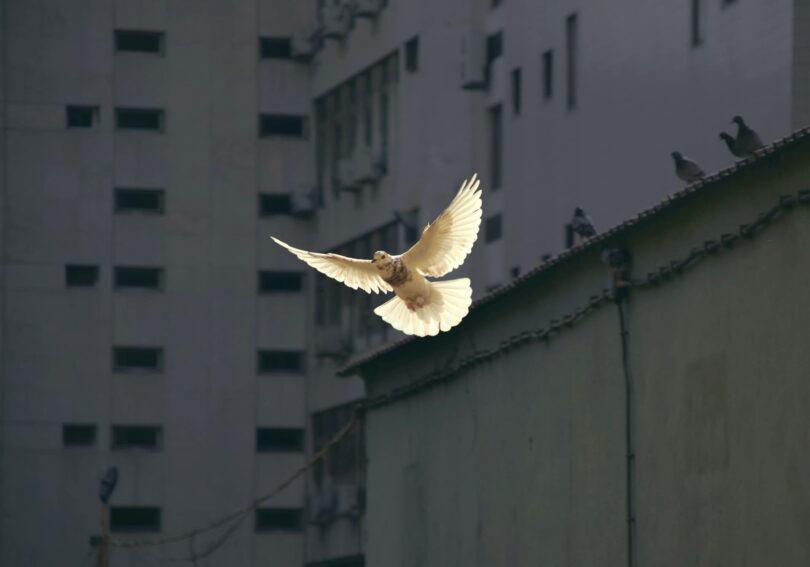Guest writer for Wake Up World
Let’s be honest here, being present in the moment sounds good in theory … but in practice, we suck at it 99.9% of the time.
How many times have you found yourself making all these fancy mental plans of “being as present as you possibly can” and imagining yourself as a Zen-master-to-be or advanced yogi in the making … and then a few minutes later you’re crunching down a packet of Doritos and staring vacantly at the Instagram stream on your phone?
Can you relate to this frustrating phenomenon?
It seems like everywhere we look in the realm of wellness, self-help, and spirituality, being present is glorified as the highest of virtues. And I have nothing against that because it’s true. Being present is really the only sane way to live life.
But there’s one sticky issue that I’ll cover in this article, along with some down-to-earth advice for how to be more present each day.
What Does ‘Being Present’ Mean?
Being present simply means inhabiting this moment without getting lost in thoughts about the past or the future. When we’re being present, we’re vividly awake and conscious of what is going on in the here-now.
A definition of being present often used is quoted from professor and founder of Mindfulness-Based Stress Reduction, Jon Kabat Zinn, who defines the present moment (or mindfulness) as:
… paying attention, on purpose, in the present moment, non-judgementally.
The Power of Presence: Why it’s the Solution to Nearly Everything

With popular books like ‘Be Here Now’ by guru Ram Dass published in the 1970s and ‘The Power of Now’ published in the 2000s by spiritual teacher Eckhart Tolle, most of us on the spiritual path are aware of the power of being present.
We can recognize that when we’re fully living in the here and now, we’re not suffering as much from the baggage of the past or future anxieties.
Being present helps us to tend to our needs, be more thoughtful and empathetic with others, make wiser and more conscious choices, listen to our Soul’s deeper impulses, slow down and appreciate life, and experience states of joy, awe, and peace.
Furthermore, when we’re present and are truly ensouled in the here-now, we’re also less identified with the fragmented and contracted sense of self that we call “ego.”
The result of this temporary ego dissolution is a feeling of more freedom, social connectedness, and even spiritual Oneness.
All in all, being present is powerful because it is the only place or space in which we can feel truly alive, at peace, and whole.
But there’s one major pitfall most of us tend to make when we’re trying to be “more in the present moment.” We’ll explore that next.
Why is Being in the “Present Moment” So Damn Hard?
I actually made a video about this question a while ago, so if you feel like watching my explanation (shared alongside Mateo), you can watch it below. Otherwise, keep reading!
At one point or another, most of us have felt frustrated about and disappointed by our inability to “stay in the present moment.” We’re prone to wondering things like, “Why can’t I just be more present? Why is it so damn hard? What’s wrong with me?”
At the very worst, the whole idea of trying to be “more in the present moment” is a yardstick by which the spiritual ego within us uses to measure our worth and “spiritualness.”
In other words, that part of the ego that masquerades as “being a spiritual person” (aka. what I’m referring to as the spiritual ego here) will ultimately find the practice of being present in the moment not just a threat to its “level of spiritualness,” but also fundamentally a stressful chore and finally, a tortuously difficult activity.
But why?
To put it simply, we find it so difficult to be in the present moment because the very words – the very notion of a “moment to be in” – is totally misleading.
The Merriam-Webster Dictionary defines “moment” as “a minute portion or point of time; a comparatively brief period of time” which makes it sound like being present can only happen in a tiny little spec of the here-and-now.
“Present moment” gives our minds the impression that being present means somehow “catching” that little sliver of time that’s here, because the next moment it’ll be gone. If we don’t latch onto that tiny spec of time, our opportunity to be mindful is over!
Take a moment (there’s that word again!) to consider what “present moment” means to you … go on. Look away for a few moments from the screen and connect with what “present moment” means to you …
Does it seem like the “present moment” is a brief and passing period of time?
If so, I want to point something out here:
There’s no such thing as a “present moment” because the only moment there ever is, is this, here, now.
Even thoughts of the past or future, or getting lost in daydreams, or anything else your mind conjures, only ever happens in the this-here-now. When else could it happen? Really?
Perhaps a better and more accurate word would be present movement. Whatever is happening in the this-here-now is dynamic, alive, fresh, spontaneous, and always forever changing.
I take inspiration for this term from spiritual writer and teacher Jeff Foster, who writes:
Since the words ‘moment’ and ‘movement’ come from the same root, it may be better to call this the present movement. The present movement of life! The movement of thoughts, sensations, feelings.
There is a kind of alive effervescence to the term “present movement” as opposed to the more static and dry “present moment.”
I have personally found that connecting with the present movement is a far more enjoyable, sustainable, and realistic practice than trying to catch the next present “moment.”
Going Deeper: You ARE the Present Movement

The second part of what I’ve just written about above is that the here-now is not only an ever-changing movement, but it’s also what you are at your core.
Let me explain a little more.
The second part of why we find being present so difficult is that the separation between “I” and “the now” creates a friction that makes it seem as though you have to “get to” or “find” or “catch” the present movement – and that can keep you stuck in a never-ending mental hamster wheel of trying to “be in” the here-and-now, which paradoxically evades you. (And yet, even this search for the ever-present now always happens in the now!)
But as teacher and author Scott Kiloby writes,
In enlightenment teachings, you may hear the phrase, “be present.” But if you look around, ‘you’ are the present moment. ‘You’ are not separate from it. ‘You’ are life itself. The only thing obscuring this realization is mental and emotional activity that continuously tries to move away from this moment into a dream of past, future, and resistance to now. The notion that you are separate from life is a creation of thought.
In other words, deeper than the semantics of “present moment” vs. “present movement” is this fundamental sense of separation we feel that arises from the sense of self, the ego.
The ego is a necessary biological survival mechanism, and I’m not saying to go and “kill your ego.” But if you can see that trying to “be in the present” from the stance of the ego actually blocks your capacity to recognize that you are Life itself – which is by nature always here-now – then you’ll see why it can feel so difficult to practice being present.
As Kiloby goes on to write,
Paradise is already here, now. It has always been right here, right now under the dream that there was a “you” who was somehow separate from it and who needed to do something to find it.
This notion of paradise or freedom that comes through recognizing ourselves as the present movement of Life itself, reminds me of an old biblical quote from Jesus in which he says,
Neither shall they say, Lo here! or, lo there! for, behold, the kingdom of God is within you.
If you’re confused or unclear about anything written in this section, I encourage you to explore the nature of your sense of self.
Exploring the field of non-duality and practicing the “Who am I” self-inquiry meditation can help tremendously.
Blocks to Being Present

Let each of us examine his thoughts; he will find them wholly concerned with the past or the future. We almost never think of the present, and if we do think of it, it is only to see what light is throws on our plans for the future. The present is never our end. The past and the present are our means, the future alone our end. Thus we never actually live, but hope to live, and since we are always planning how to be happy, it is inevitable that we should never be so.
– Blaise Pascal
Now that we’ve explored the two biggest blocks to being present (the misleading idea of a “present moment” and the divisive nature of the ego), let’s explore a few other blocks.
There are many reasons why the mind wants to avoid being present. Here are some common blocks:
- Avoiding the present movement due to unresolved emotional or physical pain that makes being in the now painful
- The belief that happiness/fulfillment was in the past or is in the future
- Contracted energy in the body/nervous system that fuels thought, creating a cycle of body-mind escapism from the here-now
- Beliefs about how life “should be” and therefore a rejection of the present movement as being “too simple and too boring”
- A dense shadow self that creates addictive and escapist behavior
- Fear of the inevitable ego death (scary word for something actually quite beautiful) that comes from being truly present
The above list isn’t exhaustive, but you get the picture. And the reality is, all of these blocks happen in the present movement anyway, even if we aren’t aware or consciously tuned into it!
5 Practices For Being Present

It’s kind of ironic that I’m suggesting practices here for “being present,” when you are always and forever in the present and you don’t really need to “do” anything to “get there.”
And yet, life is a great paradox. From the perspective of the ego, which most of us operate from, we need something to do, something to orient ourselves with.
I’m not going to proclaim that there’s “nothing to do” and “nowhere to go” even though that’s technically true on an objective level. Why? I like to honor the objective and subjective. And subjectively, the mind needs something to chew on.
So let me throw it a bone and recommend some practices for being present:
1. Find a source of flow
The “flow state” was a term first popularized by psychologist Mihaly Csikszentmihalyi in the 1990s and describes the experience of getting so immersed in something you love that all sense of time vanishes. You’re completely in the flow and in the now.
Finding a source of flow allows you to be totally immersed in the present moment in a joyful way. The best way to find your source of flow is to discover what you love doing and what you’re passionate about.
For some people, flow comes through creating art or cooking, for others, it comes through playing sports, fixing motorcycles, or going on a hike. Ask yourself, “What do I love doing?” and notice the present movement as you’re immersed in that activity.
2. Observe babies and animals
Babies and animals are always in the present movement, in the here-and-now. Take some time to learn from them. Watch their spontaneity, their openness, their freshness.
I have two dogs in my life right now: Lila (an insanely playful Labradoodle) and Forest (a Dr. Jekyl and Mr. Hyde Shihpoo) and they are an endless source of silly, joyous, and surprisingly wise insight.
What can the innocence of children and animals teach you about being present?
3. Find the magic of solitude in nature
Nature has taught me so much about moving with the seasons, that we need to honor times of harvest and times of rest. That the frenetic pace of doing, doing, doing, without being present with each other and the season we are in, what is happening around us, is unnatural and counter to life.
– Brenda Salgado
Nature is the biggest never-ending source of dynamic movement. The movement of the wind, trees, birds, wild animals, sunshine, clouds – all of it is a magical doorway into the now.
Be assured that if you take some time to sit in nature and observe it, you’ll likely feel on a deep level what being present is all about.
I recommend solitude in nature specifically because it helps you to step out of your mind (which comes when you’re chatting with other humans) and into the flow of what is happening here-now.
4. Open awareness meditation
There are two main types of meditation (that branch off into numerous other styles of meditation): focused and open meditation.
You’re probably familiar with the “focus on your breath” style of meditation which is taught everywhere. But there’s also a slightly lesser-known form of meditation, which is open-ended and unstructured.
To practice open awareness meditation, dedicate twenty minutes or more to sitting somewhere undisturbed and simply watching whatever comes into your field of awareness. Don’t try to control, change, or focus in particular on anything. Just let it all come and go.
Thoughts, feelings, sounds, bodily sensations, colors, vibrations, memories, smells, and literally anything/everything will likely pop into your awareness. Simply watch how it dances and changes, and notice what it’s like to be present in this state.
You might even like to try out this guided open awareness meditation from Rupert Spira (which will help you out):
5. Use the mantra “so hum”
Chanting mantras is a sacred spiritual practice that has been used for thousands of years to calm and center the mind.
Above I described the process of open awareness meditation – here, by using a mantra, we’re adopting a more focused form of meditation. But this focus doesn’t have to be rigid or constricted. The purpose of mantras is to focus but also open your awareness.
Why do I recommend the “So Hum” mantra in particular? Firstly, this mantra is easy to remember and practically anyone can easily recall it during the day.
Secondly, “So Hum” can be used easily along with the breath. “So” mimics the in-breath, and “Hum” mimics the out-breath. You can even draw them out to make this mantra extra engaging as in “soooooooo” (breath in) “huuuuuummmmmmm” (breath out).
Thirdly, So Hum is a Sanskrit word that translates to “I am that” which beautifully mirrors what I wrote previously in this article: that beneath the ego, we are Life itself appearing as this present movement. In other words, “I am that” (“So Hum”).
The So Hum mantra can be used throughout your day either silently in your mind, in a whispered breath, or out loud (depending on the situation). This is a mantra that can give your mind something to gnaw on while simultaneously quietening down your inner landscape enough to recognize the present movement of what is happening, right here, right now.
I like to use this mantra in a spontaneous sing-song way so that it doesn’t become monotonous. Be creative and know that you don’t need to confine your mantra to a dull drone or a compartmentalized practice that you do for only part of the day. Live and breathe it!
And as you’re saying the mantra, notice whatever is happening right now – that could be seeing a pile of dog shit on the sidewalk, listening to a car zooming by, feeling pain in your arms, hearing a bird chirping, feeling your heart thumping … or literally anything!
Final Words

Being present doesn’t need to be a chore, something we “arrive to,” a virtue we cultivate, a special place we’re granted special access to, or anything of the like.
Being present is always available.
It cannot be found over there, or in thought, or in a special spiritual formula, or in an idealistic dream of a perfect spiritual seeker – that present movement of energy is here, right now. It’s even appearing as the thoughts, contractions, false identifications, mental stories, and beliefs about having to “catch” the present “moment.”
When we shift away from seeing the here-now as a tiny slice of time that we need to fight to hold onto and recognize that the here-now is actually a dynamic, ever-changing, vivacious aliveness, being present become more fun!
We begin to see that the here-now isn’t a present “moment” but a present movement, and that deeper than the ego, we are that chi, that life force energy, kundalini, prana, Spirit – whatever you want to call it – that appears as all things.
What is your experience and relationship with being present? I’d love to hear any epiphanies or adventures you’ve been on surrounding this topic.
Also, please feel free to share this article with someone if you feel they might enjoy reading it!
About the author:
Aletheia Luna is a prolific psychospiritual writer, author, and spiritual mentor whose work has touched the lives of millions worldwide. As a survivor of fundamentalist religious abuse, her mission is to help others find love, strength, and inner light in even the darkest places. She is the author of hundreds of popular articles, as well as numerous books and journals on the topics of Self-Love, Spiritual Awakening, and more. See more of her work at lonerwolf.com.
This article, 5 Practices for Being Present, was originally published on lonerwolf.com, reproduced with permission.

If you've ever found value in our articles, we'd greatly appreciate your support by purchasing Mindful Meditation Techniques for Kids - A Practical Guide for Adults to Empower Kids with the Gift of Inner Peace and Resilience for Life.
In the spirit of mindfulness, we encourage you to choose the paperback version. Delve into its pages away from screen glare and notifications, allowing yourself to fully immerse in the transformative practices within. The physical book enriches the learning process and serves as a tangible commitment to mindfulness, easily shared among family and friends.
Over the past few years, Wake Up World has faced significant online censorship, impacting our financial ability to stay online. Instead of soliciting donations, we're exploring win-win solutions with our readers to remain financially viable. Moving into book publishing, we hope to secure ongoing funds to continue our mission. With over 8,500 articles published in the past 13 years, we are committed to keeping our content free and accessible to everyone, without resorting to a paywall.








